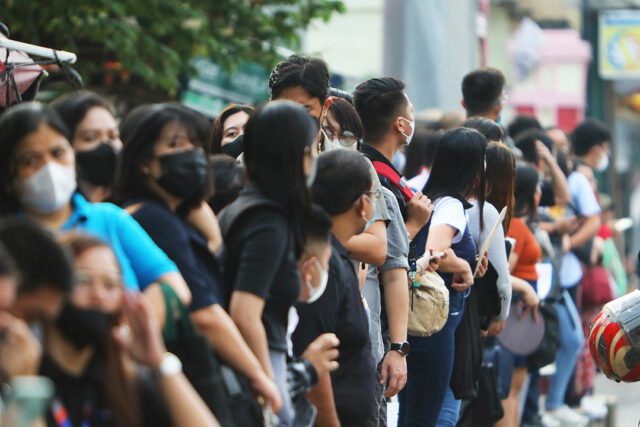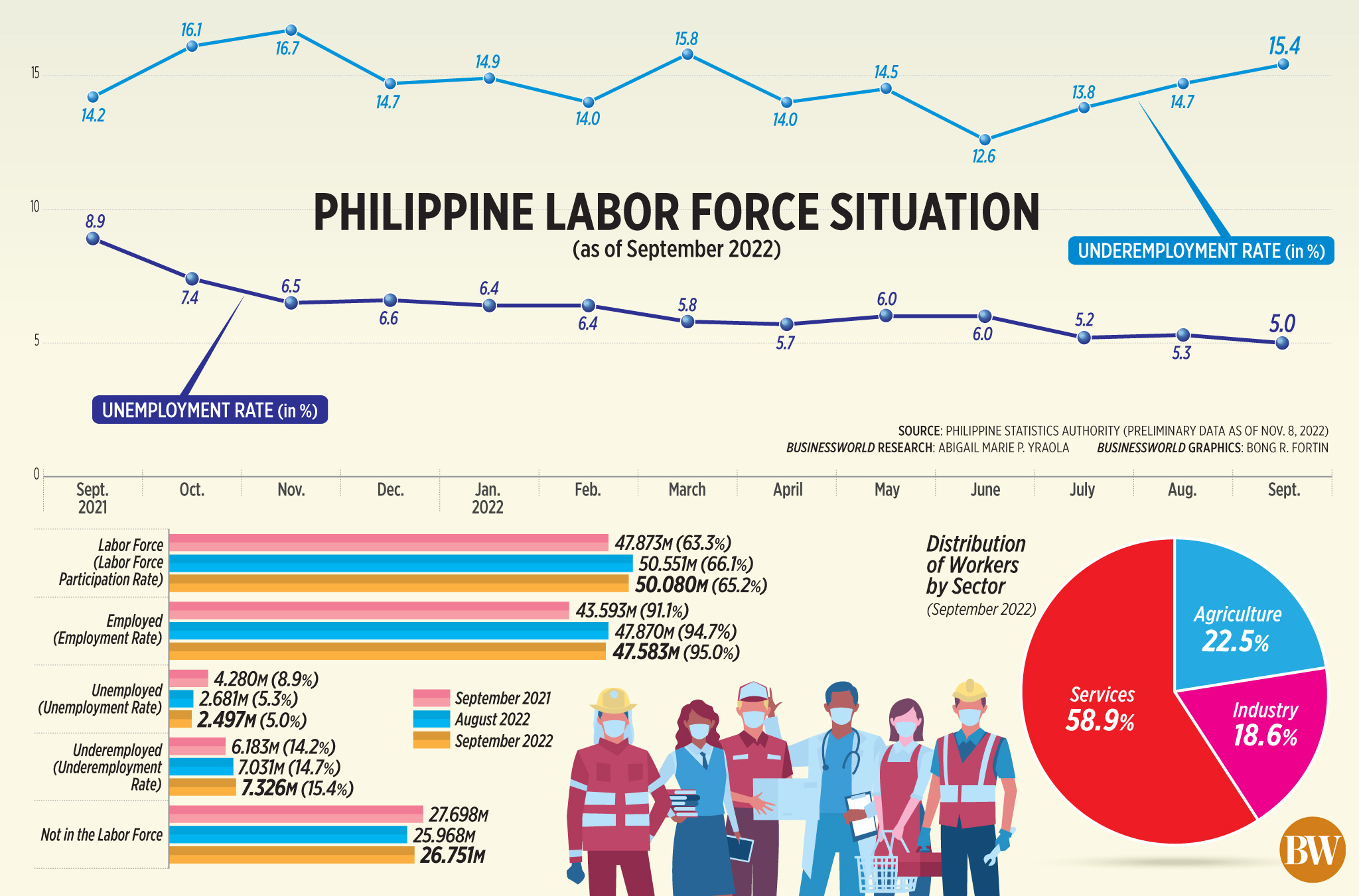
By John Victor D. Ordoñez, Reporter
THE UNEMPLOYMENT RATE in September dropped to a new low since the start of the coronavirus pandemic, but job quality continued to worsen, the Philippine Statistics Authority (PSA) said on Tuesday.
Preliminary data from the PSA’s Labor Force Survey (LFS) showed the September jobless rate eased to 5%, from 5.3% % in August and 8.9% in the same month last year.
This was equivalent to 2.5 million jobless Filipinos in September, lower than 2.681 million in August and 4.28 million in September 2021.
The month saw the lowest number of unemployed Filipinos since October 2019, when 2.05 million were jobless.
“The recent survey results show the gains of the full reopening of our economy,” Socioeconomic Planning Secretary Arsenio M. Balisacan said in a statement.
Metro Manila and most provinces have been at the most lenient alert level since March, allowing businesses to operate at full capacity.
However, job quality further deteriorated in September as the underemployment rate — or the rate of employed Filipinos seeking for more work — rose to a six-month high of 15.4%. This was higher than the 14.7% underemployment rate in August, and 14.2% a year earlier.
September also marked the third straight month that underemployment has increased.
In absolute terms, the number of underemployed Filipinos increased to 7.33 million in September from 7.031 million in August, “as more than 882,000 individuals sought to earn additional income with the spike in commodity prices due to inflation,” the National Economic and Development Authority (NEDA) said.
Labor Force Participation Rate (LFPR) — the share of the Filipino workforce to the total working age population of 15 years old and over — slipped to 65.2% in September, from 66.1% in August. The September LFPR was still higher than the 63.3% seen a year ago.
The size of the total labor force dropped to 50.08 million in September, from 50.551 million in August.
PSA Undersecretary and National Statistician Claire Dennis S. Mapa said the school opening in September led to some to opt out of the job market and return to the classroom.
Mr. Mapa said the unemployment rate will likely stay near the 5% level for the last three months of 2022. For the nine-month period, the unemployment rate already averaged 5.7%.
In 2019, the unemployment rate was at 5.1%.
“Before the pandemic, there was a seasonal increase in employment numbers and percentage, and there was a decrease in unemployed numbers and percentage in the last quarter, primarily because we have a lot of seasonal jobs, at the malls and shops. With the current condition we don’t know if it will show up in the numbers,” he said in mixed English and Filipino.
Elevated inflation may hurt job creation in the next few months.
“Of course, the increasing inflation rate will bring challenges since it will impact the demand for jobs,” Mr. Mapa said.
Headline inflation accelerated to 7.7% in October from 6.9% in September which was the fastest increase in nearly 14 years.
Meanwhile, the employment rate stood at 95% in September, up from 94.7 in August and 91.1% in the same month a year ago. The NEDA said this was the highest recorded employment rate since January 2022, mainly due to the “significant de-escalation of community quarantine restrictions.”
This translated to 47.58 million employed Filipinos, slightly less than 47.87 million a month prior but higher than the 43.59 million in September 2021.
PSA data showed an employed Filipino on average worked 39.6 hours a week in September compared with 40.5 weekly hours in August.
By sector, services remained the top employer as it accounted for 58.9% of the total working population, followed by agriculture (22.5%) and industry (18.6%).
The manufacturing sector posted the highest monthly increase in jobs, adding 780,000 to 4.45 million workers in September.
“(The manufacturing jobs growth) speaks positively of the resilience of demand despite high costs of doing business. However, persistently high costs of raw materials, borrowing, and labor, as well as a dimmer external outlook could impede job growth in the sector,” China Banking Corp. Chief Economist Domini S. Velasquez said in a Quick Take report.
On the other hand, wholesale and retail trade saw jobs drop by 335,000 to 10.71 million in September.
Ms. Velasquez said job losses were seen particularly in food and beverage retail, such as supermarkets and sari-sari stores, “as rising input costs likely squeezed profits.”
PSA data also showed 120,000 job losses in agriculture and forestry in September.
“With fewer laborers for production, domestic supply of agricultural commodities could be at risk and possibly stoke inflation further,” Ms. Velasquez said.
Michael L. Ricafort, chief economist at Rizal Commercial Banking Corp., said the jobs situation may improve in December as companies typically hire more to cope with increased demand.
“During the holiday season, some companies have seasonal increases in employment. They also post their highest revenues of the year,” he said in a Viber message.
China Bank’s Ms. Velasquez said the outlook for underemployment is “shaky.”
“Underemployment will likely remain elevated as high inflation leaves low-income workers looking for additional income to augment higher cost of living,” she said.
Federation of Free Workers Vice-President Julius H. Cainglet said workers still need higher wages to cope with rising prices of food and utilities.
Job quality worsens in September
Source: Bantay Radio

0 Comments